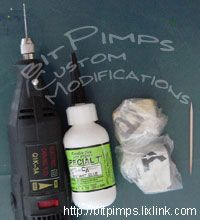Alloy Rim Installation – Part 1: Parts & Tools To Get The Job Done
by CaboWabo
Along the way in this tutorial, we’ll not only discuss how to install the alloy rims, but we’ll note a few of the differences between the rims themselves – as well as the various suggested installation methods. Now let’s begin.
First, let’s take a look at the parts we’ll be needing to get the job done*:
(the asterisk denotes a difference, we’ll discuss this just below)
- 4 rim rings
- 4 rim backings
- 4 hubs
- 4 rotors and calipers
- 4 tires
- set of knuckles
- rear axle and gear
This is where we might run in to our first differences. As noted above, we have 4 of each component that makes up our set of alloy rims. The list and image above are of 10 mm rims, as such, other styles and sizes may come with more or less components. For example, one may get a set of rims where the rings and backings are all in one piece. These differences are minor and insignificant to the basic installation methods for the most part.
 Next, let’s take a look at the tools we’re going to need to get the job done:
Next, let’s take a look at the tools we’re going to need to get the job done:
(the asterisk denotes a difference, we’ll discuss this just below)
- epoxy resin, putty, etc. or paper *
- super glue or an equivalent
Here’s another spot where we might run in to some differences in installation methods, as we’ll find out more later in Part 2 (preparing the parts for mounting) of this article. We can choose to use epoxy resin, putty, etc. or paper. I recommend epoxy, that is what I used and have had successful results – therefore we’ll be showing and explaining the “fill” (epoxy resin, putty, etc.) method rather than the “wrap” (paper, tape, etc.) method. If you would like to use the wrap method, you can read about it being used and how to do it in our Rollin’ On Dubs Thanks To Pullbacks article.


